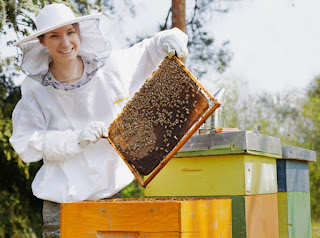Supplying the Beekeeper with All of His Needs
Safety in beekeeping begins with the use of correct beekeeping supplies. Beekeeping may be a risky and destructive sport if the beekeepers do not take the necessary precautions when out in the open. Honey extraction, colony management, and beekeeping supplies are all tasks that need the use of beekeeper supplies.
In the case of beekeeping, one of the most pressing considerations is the safety of those tending the hives. A beekeeper's coat, gloves, a beekeeper's hat, and a veil for a hat are all necessary safety gear. The face is the most sensitive area of the body to bee stings, therefore before beginning any beekeeping operation, wear a hat with a veil. Additionally, beekeepers are obliged to wear a protective beekeeping outfit that serves as the body's defense against bee stings. Bee stings are unable to penetrate this protective garment, which is both lightweight and full-length. Another essential piece of safety equipment for beekeepers is a pair of gloves, which they should wear while working with the colony. Other beekeepers dislike them, but they provide excellent hand protection.
When it comes to calming down bees, many beekeepers choose to smoke them as their preferred method. A different kind of gadget is used to produce smoke. Rotten wood, hessian, burlap, twine, pine needles, and corrugated cardboard are some of the most often utilized fuels. Others favored pulped paper, compressed cotton, or aerosol smoke cans as a more environmentally friendly alternative.
Traditionally, the bees' feeding reaction is signaled by a puff of smoky air. In the event of a fire, this reaction will help get the bees ready to leave the hive. It also prevents the guards from immediately emitting intruder-sensing alarm pheromones because of the smoke. The beekeepers will be able to access the hives and carry out their duties without being attacked by the bees thanks to the confusion caused by the smoke.
Bees, on the other hand, can forage for their nourishment. Some beekeepers, on the other hand, choose to feed their hives sugar syrup as a nutritional supplement. In the case of a food shortage, this is an excellent strategy for preventing malnutrition. Sugar syrup used as supplemental food for bees has several other advantages, one of which is the encouragement of egg-laying. Beekeepers have the choice of employing a variety of feeders, as well. Beekeepers may feed their colonies using hive tops, pails, or division boards throughout the winter months. During the summer, bees are known to be out and about, thus the usage of entrance feeders is common.
Housing the bees is the most important part of beekeeping. It is possible to keep honeybee colonies inside of an artificial hive, and the honeybees are encouraged to build harvest-convenient combs out of wax foundations made of ultra-thin sheets. Each side of the hexagon is embossed to make it simpler for the bees to create their honeycomb.
What a Beekeeping Handbook Is Worth
Being involved in the world of beekeeping is both rewarding and educational. Beekeeping might be a lucrative side business for you. However, raising bees requires a lot of time and effort. A beekeeping handbook is a need if you plan on becoming a beekeeper and want to learn all there is to know about beekeeping click here.
Because many new beekeepers lack basic knowledge about beekeeping, it is reasonable to assume that they will have a slew of questions. With this book, you'll learn all there is to know about beekeeping from start to finish. In addition, this guide will assist you in getting started and even determining whether or not beekeeping is a viable option for you in your location. There are regions where beekeepers and hobbyists are not allowed to grow bees. Both the ecosystem and humans gain from honey bees. Wasps, hornets, and wild bees are among the pests they expel. Beekeeping newbies are often concerned about where to get the essential materials and equipment. Buying materials that you are unfamiliar with might be a frightening experience for newcomers to the sport. Using a beekeeping guide may lead you to the finest suppliers and manufacturers for your equipment and supplies.
Once you've learned the basics of beekeeping and where to get your supplies and equipment, you must get to know the small critters you'll be working with. As many people are aware, keeping bees isn't a common or routine hobby since it involves dealing with aggressive and sometimes harmful insects. Inexperienced beekeepers might find honey bees a nuisance, especially if they don't know how to properly handle and approach them. When interacting with honey bees, it's important to use protective clothing and equipment. Keepers of bees should be aware of the risks involved, particularly newcomers. Beekeeping is a complicated endeavor that demands thorough preparation and knowledge on your part. Everything you need to know about beekeeping is included in the book.
Honey is the primary goal of beekeeping. Starters should have a handbook to help them through the honey-gathering procedure. Helps newbies learn about the right way to handle honey in the beekeeping handbook It's crucial to know how honey is made and how it functions to get the most out of it. Even if it isn't tough, beginning beekeepers should know and comprehend the whole honey production process since it isn't entirely dependent on their efforts.
While beekeeping is not for the faint of heart, it can be taught with a little common sense and a little patience. However, beekeeping has several challenging aspects that must be completely comprehended, such as how to properly manage honey bees and their hives and how to maintain them healthily. The beekeeping handbook provides novices with all of the information they need to get started, and it also serves as a mentor to support them every step of the way. With this, beekeeping success is guaranteed.

Comments
Post a Comment